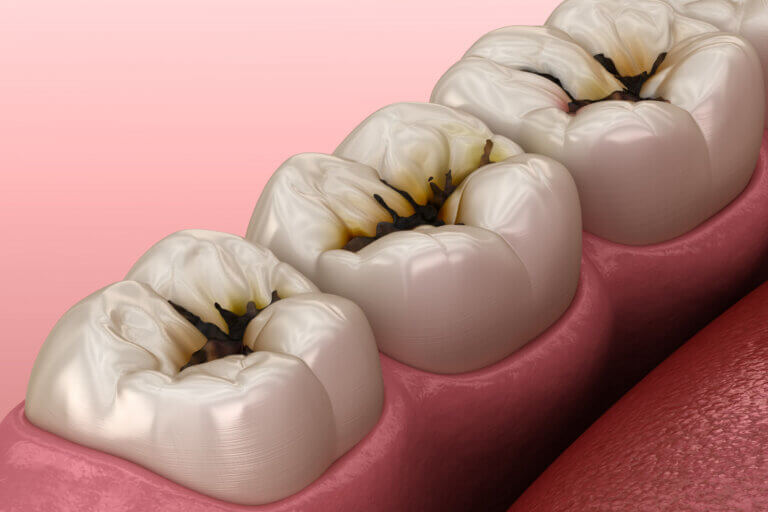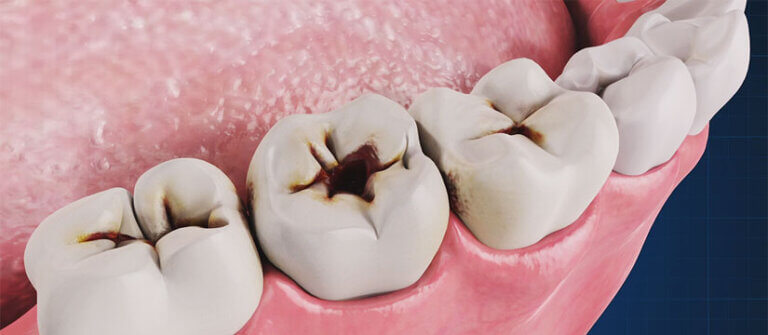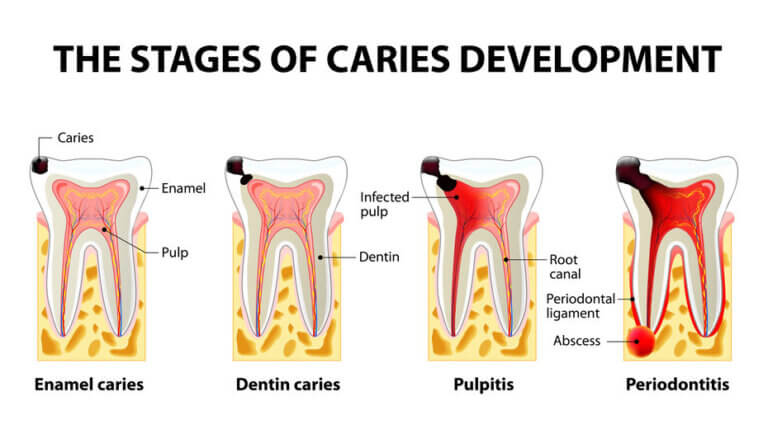Cavity

What Is A Cavity?
A Cavity, also known as dental caries, is one of the most common dental problems worldwide, affecting individuals of all ages. A cavity is essentially a small hole or area of damage on a tooth caused when the protective enamel layer is weakened by acids produced by bacteria in the mouth. Without timely treatment, cavities can worsen, leading to pain, infections, and even tooth loss.
Cavities can be prevented and treated with the right dental care. If you’re concerned about a cavity or tooth decay, here’s what you should know before seeing a Toronto dentist:
- Types Of Dental Cavities
- Causes of Cavities
- Signs And Symptoms Of A Cavity
- Treatment Options For A Cavity
- Managing A Cavity Until You Can See The Dentist
- Try Our Cavity Risk Quiz
- Frequently Asked Questions About Cavities
If you have questions about A Cavity or other dental problems, please contact us for more information.
Types Of Dental Cavities
There are different types of cavities, depending on where they occur on the tooth:
- Pit and Fissure Cavities: These occur in the grooves and pits on the chewing surfaces of back teeth (molars). These areas can trap food particles and plaque, making them more prone to decay.
- Recurrent Cavities: These occur around the edges of dental fillings, crowns, or other dental restorations. Over time, the restoration can wear down, or the surrounding tooth structure can decay, allowing bacteria to infiltrate the area.
- Interproximal Cavities: These form between the teeth (in the interproximal spaces), where it’s harder to clean thoroughly with regular brushing. Flossing is crucial to prevent decay in these areas.
- Root Cavities: These affect the roots of the teeth, which are not covered by enamel. People with receding gums are more susceptible to this type of decay as the root surfaces are exposed and more vulnerable.

Causes of Cavities
Cavities are caused by several factors, including:
- Poor oral hygiene: Not brushing or flossing regularly allows plaque to build up, leading to acid production that damages enamel.
- Sugary and acidic foods/drinks: Consuming a lot of sugary or acidic items encourages bacterial growth, which contributes to enamel breakdown.
- Dry mouth: Saliva helps neutralize acid and wash away food particles, so a lack of it can increase the risk of cavities.
- Genetics: Some people naturally have weaker enamel or less saliva production, making them more prone to cavities.
- Age: Over time, tooth enamel weakens, increasing the likelihood of decay.
- Health conditions: Disorders like anorexia, bulimia, or acid reflux expose teeth to stomach acids, damaging the enamel. Additionally, radiation therapy to the head or neck can reduce saliva production.
- Inadequate fluoride: Fluoride strengthens enamel, so a lack of exposure to fluoridated water or dental products can increase your risk.
By taking steps to maintain good oral hygiene and avoiding sugary and acidic foods and drinks, you can significantly reduce your risk of developing cavities. If you have further questions about a Cavity, please contact us.
Signs And Symptoms Of A Cavity
Cavities may not cause noticeable symptoms in the early stages. However, as they progress, you may experience:
- Tooth sensitivity: Discomfort or pain when consuming hot, cold, sweet, or acidic foods.
- Toothache: Persistent pain, especially when biting or chewing, can indicate advanced decay.
- Visible holes or pits: As the cavity worsens, you may notice holes or pits on the surface of the tooth.
- Discoloration: Cavities can cause white, brown, or black stains on teeth.
If you notice any of these signs, it’s essential to visit your dentist promptly. Early detection can prevent more serious issues like infections or tooth loss. If you have further questions about signs and symptoms of a Cavity, please contact us.
Treatment Options For A Cavity
The right treatment depends on how advanced the cavity is:
- Fluoride Treatments: Early-stage cavities can sometimes be reversed with fluoride applications to remineralize the root surface.
- Silver Diamine Fluoride (SDF): A non-invasive option to halt decay progression, particularly in patients who can’t undergo more extensive treatments.
- Fillings: For smaller cavities, your dentist can remove the decayed portion of the tooth and fill it with materials such as composite resin or amalgam.
- Crowns: If a significant portion of the tooth is damaged, a dental crown may be necessary to restore its shape and strength.
- Root Canal Therapy: When the decay reaches the tooth’s nerve, a root canal may be needed to remove the infected tissue.
- Extraction: In severe cases, where the tooth cannot be saved, it may need to be extracted and replaced with an implant, bridge, or denture.
It’s important to note that early detection and treatment of cavities can help prevent the need for more extensive and costly dental procedures in the future. If you have further questions about Cavity treatment options, please contact us.

Managing A Cavity Until You Can See The Dentist
If you suspect you have a cavity but can’t get to the dentist right away, you can take the following steps to manage the symptoms:
- Rinse with saltwater to reduce pain and inflammation.
- Use over-the-counter pain relievers like ibuprofen or acetaminophen for discomfort.
- Avoid hard, sticky, or sugary foods that can worsen the cavity.
- Apply temporary fillings (available at drugstores) to protect the cavity until your dental appointment.
- Practice good oral hygiene to prevent the decay from getting worse.
These measures are only temporary. It’s important to visit your dentist as soon as possible to address the cavity and avoid further damage. If you have further questions about managing Cavities, please contact us.
Cavity Risk Self Quiz
Try Our free online dental caries risk assessment quiz based on the California Dental Association’s Caries Management by Risk Assessment (CAMBRA) designed for patients aged 6 years and older. This caries risk assessment tool is meant to give you an idea of your level of dental caries risk, and by no means substitute for an oral exam by a dental professional. Please contact us for a more complete examination.
Frequently Asked Questions About Cavities
- Can cavities form between teeth?
Yes, cavities can form between teeth where food and plaque accumulate if not cleaned properly. Flossing daily helps prevent cavities in these hard-to-reach areas.
- Can cavities be reversed?
In their earliest stages, cavities can sometimes be stopped or reversed with fluoride treatments and improved oral hygiene. However, once the enamel is permanently damaged, a filling or other treatment is needed.
- Are cavities only caused by eating sugary foods?
While sugar is a major contributor, other factors like poor oral hygiene, dry mouth, and acidic foods can also lead to cavities. Regular dental cleanings and a balanced diet help reduce the risk.
- Do cavities always cause pain?
No, cavities don’t always cause pain, especially in the early stages. Pain or sensitivity typically occurs when the cavity becomes deeper and affects the tooth’s nerve.
Cavities are a common dental issue, but with proper oral hygiene and regular checkups, they can often be prevented or treated early. If you suspect you have a cavity, contact us for more information

